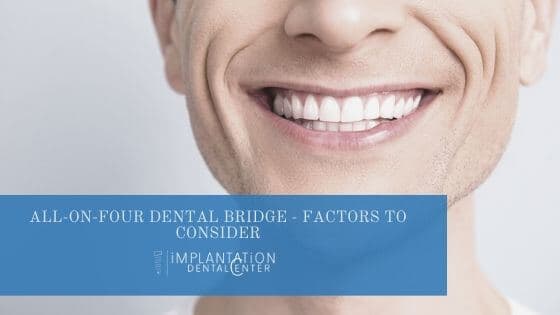The All-on-4™ dental bridge is a full arch fixed implant bridge. As a large dental bridge it solves a number of issues but it also is accompanied by possible side effects and consequences that should be considered.
5 Factors to Consider When Determining Whether the All On Four Dental Bridge is Right
Speech Issues
Implanting this dental bridge can lead to the replacement of more than just the volume of the missing teeth. The device is built for strength so it tends to be larger than other options.
In order to place this dental bridge, a dentist must remove and replace healthy bone and soft-tissue. This results in a bulkier replacement to the bone and tissue. This creates difficulties for a patient when they are making the sounds necessary for “D”, “T”, and “N”. This is caused by changes in the way the tongue moves during speech.
Fortunately, with practice and time patients can retrain their tongue to make the proper sounds and allow them to speak clearly. For the patient who does not want this impact on their speech, there are other implant options available that do not remove as much bone or tissue.
Difficulty adapting to the thickness of the bridge
Patients often have a hard time adapting to the size of the dental bridge. The contrast between the feeling of real soft tissue and artificial soft tissue is enough to cause problems. Because of this, it is important that a dentist or other dental professional takes time to educate their patient on the specific changes that they may experience with the All-on-4™ dental bridge.
Proprioception
This has to do with teeth sensitivity to force. The dental implant is missing the periodontal ligament which results in lacking feeling force. This replacement takes 10 times more force to register. This is an issue when it comes to excessive biting force and occlusal contacts. Feedback that assists with refined motor movements allows for chewing efficiency. When this is replaced with dual-arch implants the result is poorer chewing efficiency and greater stress on the implant. Commonly, this leads to broken temporary bridges, tooth popping, and other complications.
Parafunction
Natural teeth detect force more easily than implants which is something that should be taken into consideration when designing the treatment plan. By leaving more natural teeth, the patient can better recognize force such as clenching and chewing.
If all of the teeth need to be replaced there are other options available. Bar over dentures can reduce strain on supporting implants and bone.
High caries index
Some patients with dental bridges have decayed or missing teeth in the untreated areas of their mouth. The dentist must consider whether it is more important to save the teeth or to protect the implants from damage.
If you’re interested in learning about dental bridge options, including the All-on-4™, contact our office today and schedule an appointment.



